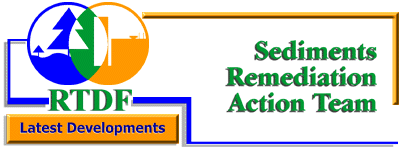
|
||||||||

|
||||||||
Weight-of-Evidence Approach for Evaluating Monitored Natural Recovery
![]()
|
Monitored natural recovery (MNR) is a sediment cleanup method that uses ongoing, naturally occurring processes to contain, destroy, or otherwise reduce the bioavailability or toxicity of contaminants in sediment. These processes may include multiple physical, biological, and chemical mechanisms that act together to reduce the risk posed by the contaminants. An evaluation of MNR should include sufficient data and information to demonstrate and support the selection of MNR as a remedy or remedy component. To meet this need, a "weight-of-evidence" approach for evaluating the use of MNR has been developed by individual members of the Sediments Remediation Action Team under the Remediation Technologies Development Forum (RTDF). Through a series of five working draft papers, the "weight-of-evidence" framework presents five interrelated elements—based on site-specific information—to assess the use and effectiveness of MNR:
The draft papers are meant to serve as a resource to interested parties, but are not intended to be comprehensive or provide detailed information. Interested parties are free to raise questions and objections regarding the "weight-of-evidence" approach provided in the papers. The RTDF Sediments Remediation Action Team is seeking and welcomes public comments on the papers. The five draft papers represent the views of the authors and have not been subjected to EPA peer review. Therefore, it does not necessarily reflect the views of the EPA, and no official endorsement should be inferred. The papers are not a regulation, and therefore, they do not impose legally binding requirements on EPA, States, or the regulated community, and may not apply to a particular situation based upon the circumstances. The papers are working drafts and may be revised periodically without public notice. Use or mention of trade names does not constitute endorsement or recommendation for use. Previous versions of the five papers have been published under Proceedings: Second International Conference on Remediation of Contaminated Sediments; Venice, Italy (03 Sept to 03 Oct 2003); Battelle Press, Columbus, Ohio. These earlier versions were also not subjected to EPA peer review and, therefore, do not necessarily reflect the views of the EPA, and no official endorsement should be inferred. Framework for Evaluating the Effectiveness of Monitored Natural Recovery (MNR) as a Contaminated Sediment Management Option (96K/11pp/PDF)
|